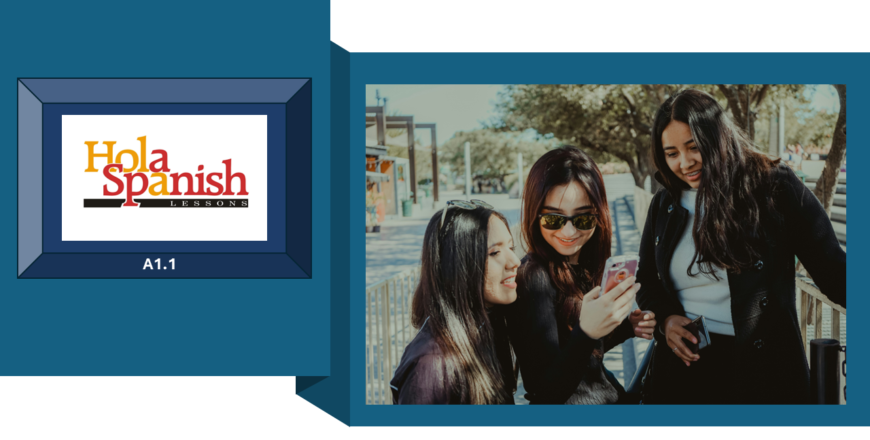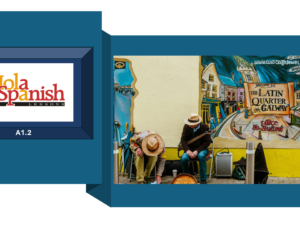A1 - M1: Introductory Spanish Foundations.
- Description
- Curriculum
- Notice
Course Description
Hola Spanish Lessons : Your Ticket to the Spanish-Speaking World
Hola, Spanish Lessons! Your Gateway to the Spanish-Speaking World
Unlock the joy of speaking Spanish with Introductory Spanish Foundations, the first step in your Spanish journey! Perfect for beginners, this course will introduce you to the essential building blocks of Spanish, empowering you to engage in simple conversations, introduce yourself, and communicate on a basic level with confidence. Whether you’re exploring Spanish-speaking cultures, planning to travel, or just eager to learn, this course opens up a world of possibilities.
By the end of the course, You will:
- Understand basic conversations and greetings in Spanish
- Introduce yourself and others effectively
- Ask and respond to questions about personal information
- Engage in simple exchanges in Spanish with confidence
Breakthrough!
How it works:
- Live sessions: Scheduled lessons that will be recorded and be available for you at any time during the course.
- Self-paced learning: Study at your own convenience with the recorded lessons and the downloadable material.
- Expert guidance: Benefit from support from native language teachers.
- Interactive lessons: Make learning fun and engaging with quizes, exercises, live sessions.
- Free access: Enjoy all course materials at no extra cost.
Ready to start your Spanish adventure?
Enroll now to experience the satisfaction of learning a new language with Introductory Spanish Foundations!
Continue your journey with Spanish Foundations A1.2, where we build on this foundation to expand your conversation skills and cultural insights.
-
1Lesson 1: Greetings and Introducing Yourself60 minutes
By the end of the lesson, students will be able to:
· Objectives
1. Learn and practice basic Spanish greetings and introductions, To greet (saludar), To Respond to a greeting (Responder a un salud).
2. To Introduce oneself and ask personal information(Presentarse y preguntar información personal), Ask and say the name and surname (Preguntar y decir el nombre y el apellido).
3. Spell your name (Deletrear tu nombre), Say goodbye (Despedirse).
· Grammar Component
1. The alphabet.
2. Singular subject pronouns.
3. Verbs “llamarse”, “apellidarse y "ser" in the present tense.
Cultural Aspect: Greeting Etiquettes in Spain and Latin America: A Cultural Insight.
-
2Lesson 2: Basic Personal Information and Numbers60 minutes
Description
By the end of the lesson, students will be able to:
· Objective:
1. Learn how to ask for and provide personal information.
2. Learn how to ask about and state your nationality.
3. Learn how to ask about and say what languages you speak.
4. Learn numbers and how to share professional information in Spanish.
5. Learn and practice Spanish numbers and counting from 1 to 20.
· Grammar Component:
1. Present tense verbs “SER”, “ESTAR”.
2. Grammatical gender: nationality adjectives, masculine and feminine.
3. Interrogatives: "¿dónde?" (where?), "¿qué?" (what?), "¿cómo?" (how?), "¿cuánto/s?" (how much/many?).
· Cultural Aspect: Demographics and economy of Spanish-speaking countries.
-
3Lesson 3: Professions, Jobs, and Workplaces60 minutes
Description
· Objective:
1. Learn vocabulary related to professions.
2. Learn office-related vocabulary and objects.
3. Identify masculine and feminine words.
4. Learn how to change singular words to plural words.
· Grammar Part:
1. Masculine and Feminine
2. Gender agreement exceptions
3. Singular and Plural
4. Definite and indefinite articles
· Cultural Aspect: Office culture in Spanish-speaking
-
4Lesson 4: Describing People – Physical and Personality Traits60 minutes
Description
· Objective:
1. Learning the vocabulary of part of the body
2. Learn and practice basic Spanish adjectives to describe people and things
3. Introduce someone and respond to an introduction
- Grammar Component:
1. Agreement of adjectives with nouns
2. The use of "ser" , "tener", “llevar” for people’s descriptions
- Cultural Aspect: How physical appearances and personal traits are described in Spanish-speaking cultures
-
5Lesson 5: Talking About Family, Age, and Character60 minutes
Objective
By the end of this lesson, students will be able to:
1. Ask for and give information about family. Example: ¿Cómo se llama tu hermano? (What is your brother’s name?)
2. Ask for and give information about marital status. Example: ¿Estás casado/a? (Are you married?)
3. Ask for and give information about age. Example: ¿Cuántos años tiene tu padre? (How old is your father?)
4. Physically describe a person. Example: Mi madre es alta y tiene el pelo rubio. (My mother is tall and has blonde hair.)
5. Talk about a person's carácter. Example: Mi hermano es muy trabajador y simpático. (My brother is very hardworking and friendly.)
6. Identify a person. Example: Ese es mi tío, el que vive en México. (That is my uncle, the one who lives in Mexico.)
Grammar Component
1. Possessive adjectives and the verb "tener" to talk about family relationships
Example: Mi hermana tiene dos hijos. (My sister has two children.)2. Present indicative tense: verbs estar and tener; verbs ser, hablar, trabajar, estudiar, and vivir (3rd person plural)
Example: Mis padres trabajan en una empresa. (My parents work in a company.)3. Grammatical number: nouns and descriptive adjectives
Example: Mis hermanos son altos. (My brothers are tall.)4. Possessives: mi(s), tu(s), su(s)
Example: Mi abuela vive en España. (My grandmother lives in Spain.)5. Agreement of the adjective with the noun in gender and number
Example: Mi hermana es simpática y mis primos son divertidos. (My sister is nice, and my cousins are fun.)6. Interrogatives: ¿quién?, ¿cuántos/-as?, ¿cómo?
Example: ¿Quién es tu hermano? (Who is your brother?)7. Quantifiers: muy, bastante
Example: Mi prima es muy amable. (My cousin is very kind.) -
6Lesson 6: Daily Routines and Activities60 minutes
Lesson 6: Daily Routines and Activities
Description
By the end of the lesson, students will be able to:
Objective:
1. Learn and practice vocabulary related to daily routines and activities, days of the week, months, and dates in Spanish
2. Speak about a normal day
3. Habitual actions
4. Talking about daily habits
5. Asking and saying what time things are done
6. Talk about your birthday and ask for other´s birthday date
Grammar Component:
1. Reflexive verbs and their conjugation in the present tense
2. The use of articles with days of the week and months
Cultural Aspect: Typical daily routines in Spanish-speaking countries
-
7Lesson 7:My House and My Room60 minutes
Description
By the end of the lesson, students will be able to:
- Objective:
1. Describing a house
2. Describing a room
3. Expressing existence
4. Expressing location in space
- Grammar Component:
1. Verb ser: descriptions
2. Verb estar: location in space
3. Hay + indefinite article – Estar + definite article
4. Prepositions and adverbs of place
- Cultural Aspect: The houses in Spain and in Latin America, rooms around the Hispanic World, costums when you visit a house of a Spanish and a house in South America.
-
8Lesson 8: My Town, My City, My neighbourhood, public schedules, and the weather60 minutes
- Objective: Learn and practice vocabulary related to food, mealtimes, and eating habits
1. Describing a city, a town and neighbourhood
2. Expressing preferences
3. Asking and telling the time
4. Talking about the weather
5. Talking about the geographical situation of a population
6. Describing a population
7. Talking about the number of inhabitants
8. Asking and saying what the capital of a country is
9. Expressing the cause, My favorite place is...
- Grammar Component:
1. Uses of the verbs ser and estar hay, tener (tiene) for descriptions
2. Prepositions and adverbs of place: a, de, por, en, cerca (de), lejos (de)
3. Interrogatives: ¿cuántos?, ¿dónde?, ¿cómo?, ¿por qué?, ¿cuál?
4. Quantifiers: mucho/-a/-os/-as, bastante(s), poco/-a/-os/-as
5. What I like the most/least is (that)... Lo que más/menos me gusta es (que)
6. Present indicative of the verbs llover and nevar: llueve (it rains) and nieva (it snows)
7. Muy (very) - mucho (a lot)
- Cultural Aspect: La Vida Urbana y Rural en España y Latinoamérica
Productivity Hacks to Get More Done in 2018
— 28 February 2017
- Facebook News Feed Eradicator (free chrome extension) Stay focused by removing your Facebook newsfeed and replacing it with an inspirational quote. Disable the tool anytime you want to see what friends are up to!
- Hide My Inbox (free chrome extension for Gmail) Stay focused by hiding your inbox. Click "show your inbox" at a scheduled time and batch processs everything one go.
- Habitica (free mobile + web app) Gamify your to do list. Treat your life like a game and earn gold goins for getting stuff done!






